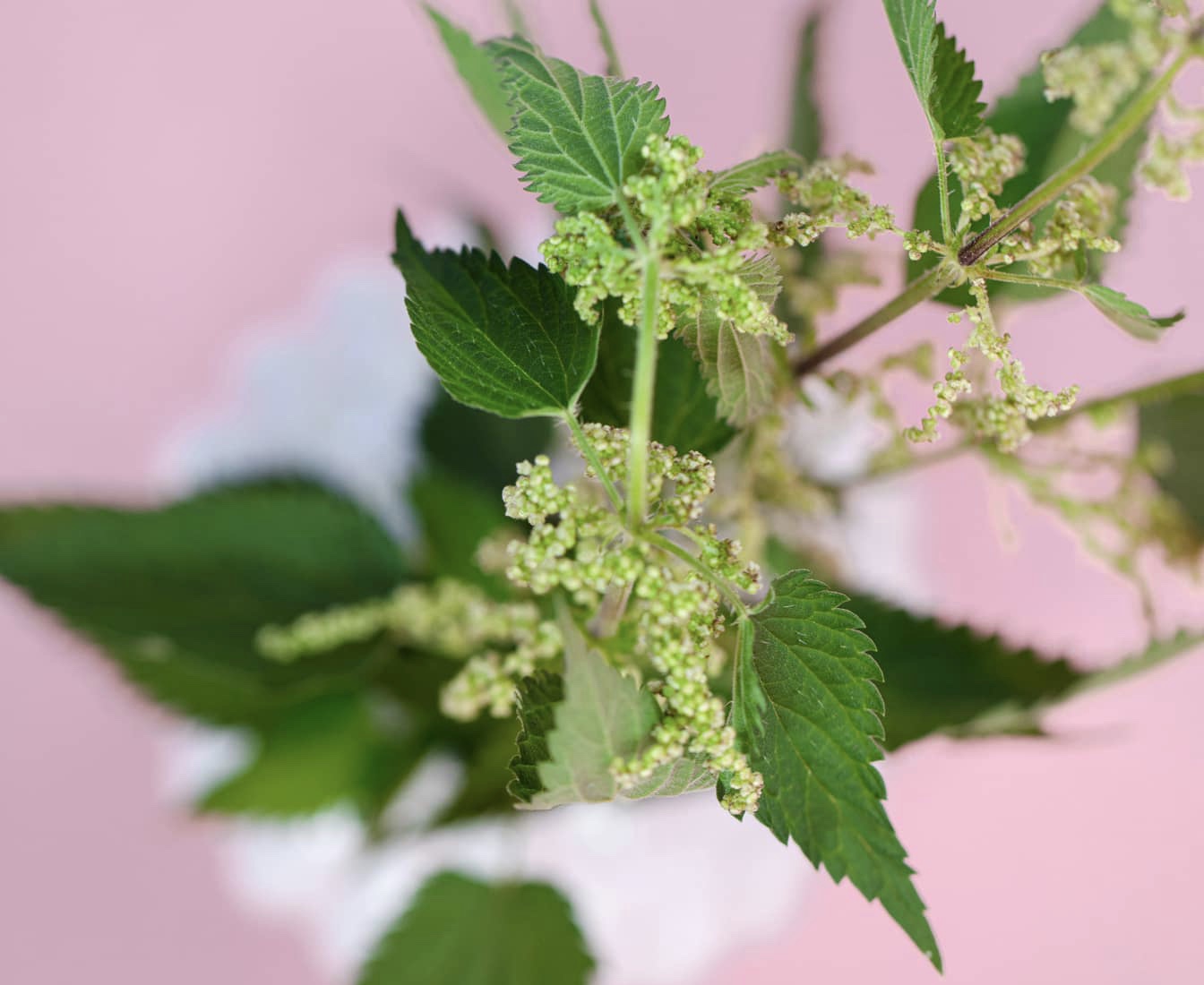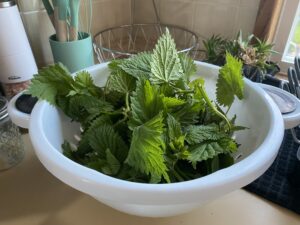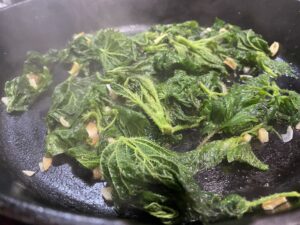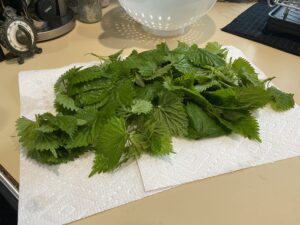Affiliate Links Disclaimer
This website participates in the Amazon Services LLC Associates Program, an affiliate advertising program designed to provide a means for sites to earn advertising fees by advertising and linking to Amazon.com.

Stinging Nettles (Urtica Dioica L.)
How I first learned about stinging nettles
When I first found out about stinging nettles, I was still very new to the world of foraging. I was a Texas girl until I moved to the state of Washington in January of 2020 (I know, great timing with the pandemic coming soon after!). I had heard of a local basketry class that piqued my interest, and I decided to give it a whirl. Really we didn’t make anything impressive in that couple of hours, but the point of the class was more to understand the multitude of opportunities that presented themselves within the natural world around us. Did I hear free art supplies? WIN!
I’ll spare you the details of the rest of the class, but to get to our topic, the instructor showed us this tub filled with water. Within it were submerged stinging nettle plants. Each one looked as though it had a miniature explosion happen within the stem. She proceeded to tell us that she was in the middle of “macerating” the plants in order to harvest the fibers in the stems. She planned to make a very strong cord, or rope, with them and it took a bit of time for them to sit in water and break apart enough to do so.
Now, that wasn’t the most interesting thing on the planet to me at the time. That being said, I was certainly surprised to hear the other attendees swoon over these “stinging nettles” and how they LOVED to gather them for making tea and soups. Were they all missing the fact that these things sting the crap out of you?! Well, that curiosity led me into a deep rabbit hole that I am delighted to share with anyone who is just as perplexed as I was.
Now then, let’s get into the nitty gritty on why this will become one of your favorite foraged foods/wildcraft ingredients.

Tip: Cleaning and drying stinging nettles you’ve foraged is much easier when using a salad spinner! (here’s my personal favorite)
Why eat them?
They are a Superfood!: Nettles are rich in protein, flavonoids, boron, vitamins (such as A, C, K, B12, B6, and B1), minerals (like iron and calcium), and antioxidants. In Nepal, they are known to be found on 5-star hotel menus. If you want to gather them, be sure to WEAR GLOVES (I personally think these ones are super cute!) to avoid being stung, and collect the young shoots or the younger tops of the plants. These will have more flavor as well as a higher concentration of the superfood qualities we’re looking for. Now, rest assured that as soon as these plants are cooked or dehydrated, they lose their sting. Otherwise, I don’t think many people would ever bother!

Cooking: I personally like to keep and simple, and sauté stinging nettles with a bit of garlic, salt, and peppers. Treat it like spinach!
Their medicinal qualities are very impressive: Here I will list out briefly the different uses stinging nettles can have in the world of human health.
- Heart health
- Blood circulation
- Gastrointestinal health
- Reduces inflammation
- Boosts the immune system
- Prevents kidney stones
- Helps maintain proper blood sugar levels
- Reduces risk of prostate cancer
- Helps in detoxification
- Strengthens bones
- Treats respiratory ailments
- Supports women’s health by reducing bloating and cramping during menstruation
- Supports a healthy pregnancy
- Helps clear urinary tract infections
- Fights viruses
Here is just one link to a summary of these properties and more of the science behind them.

Tip: Using tongs when cooking these guys is a great way to avoid the sting!
What else are they good for?
Now that you understand why we want to add them into our diet, here are some other ways these amazing plants have been used for centuries:
- Textiles: Historically, nettles have been used to make textiles such as clothing and rope. Nettle fibers are strong and durable, making them suitable for weaving into fabric. Despite what you may think, stinging nettle fiber is actually quite soft, too!
- Natural Dye: The leaves and stems of stinging nettles can be used to create a natural dye that produces various shades of green, yellow, and brown. Nettle dye has been used to color textiles, yarns, and fabrics, providing a sustainable and eco-friendly alternative to synthetic dyes.
- Gardening: Nettles are sometimes used in gardening as a natural fertilizer. When steeped in water, nettles create a nutrient-rich liquid fertilizer that can be used to feed plants and improve soil health. Stinging nettles also contain compounds that are unappealing to certain pests, such as aphids and caterpillars. Some gardeners have used nettles as a natural pest control measure by planting them around their gardens to deter unwanted insects.
- Fishing Lines: Stinging nettle fibers are known for their strength, low stretch, and durability, all the while maintaining their flexibility. When processed correctly, they created strong and resilient cords or lines, which were essential for things like fishing line or rope. Of course, being a natural fiber means if a line ever broke, it would naturally break down and have far less potential for negative impact on the natural world. The leaves themselves would even sometimes be used to attract fish!
- Musical Instrument Strings: Historically, stinging nettle fibers have been used to make strings for musical instruments such as harps and lutes. The strong and flexible nature of nettle fibers made them suitable for producing strings that could produce pleasing tones.
- Hair Rinse: Despite their stinging properties, some people use stinging nettle infusions or extracts as a hair rinse. It’s believed that the nutrients in nettles can nourish the scalp and hair, promoting hair growth and strengthening the hair follicles. However, caution should be exercised to avoid skin irritation.
- Beer Brewing: Some adventurous brewers have experimented with using stinging nettles as an ingredient in beer recipes. Nettle leaves can contribute herbal and grassy flavors to the brew, adding a unique twist to traditional beer styles.
- Wildlife Habitat: Nettles provide habitat and food for various insects and wildlife, including butterflies and certain species of birds.
- Historical Medicine: In the past, stinging nettles were used in various folk remedies and superstitions. For example, nettles were sometimes applied to the skin as a treatment for rheumatism, or worn in clothing to ward off evil spirits.
Spiritual Significance
Before I write this next segment, I want to be clear that I have much to learn about the “mystical side” of plants. I do not have any sort of practice myself, but I respect the people who do. Maybe you all can share your experiences with me and we can grow together in this area!
Stinging nettles have a long history of folklore and superstition, and some people believe they possess mystical or magical properties. Here are some mystical associations and beliefs surrounding stinging nettles:
- Protection: In various cultures, stinging nettles are associated with protection against evil spirits, negative energy, and malevolent forces. Hanging bundles of dried nettles in doorways or windows is said to ward off evil influences and bring blessings to the home.
- Warding Off Curses: Stinging nettles are sometimes used in rituals or ceremonies aimed at breaking curses or hexes. It is believed that the stinging sensation caused by nettles could dispel negative energy and remove curses when applied to the body or incorporated into magical spells.
- Prosperity and Good Luck: In some traditions, stinging nettles are considered symbols of prosperity and good luck. Carrying or wearing nettles is believed to attract abundance, success, and positive opportunities into one’s life.
- Cleansing and Purification: Stinging nettles have been used in purification rituals to cleanse the body, mind, and spirit. Bathing in nettle-infused water or smudging with burning nettle leaves is thought to remove spiritual impurities, negative emotions, and psychic blockages.
- Divination and Dreamwork: Some practitioners of magic and divination use stinging nettles in rituals aimed at enhancing psychic abilities, intuition, and dream recall. Drinking nettle tea or burning nettle leaves as incense before engaging in meditation or dreamwork is believed to heighten spiritual awareness and facilitate connection with the subconscious mind.
- Healing Charms: Nettle-based charms or talismans are sometimes carried or worn as protective amulets to promote physical, emotional, and spiritual healing. It is believed that the energy of the nettle plant could imbue the wearer with strength, resilience, and vitality.
- Fertility and Love Magic: Stinging nettles are associated with fertility and love magic in some cultures. It is believed that carrying or wearing nettles could enhance fertility, promote healthy childbirth, and attract love and romance into one’s life.
- Nature Spirits and Elementals: In folklore, stinging nettles were sometimes seen as inhabited by nature spirits or elementals. The plant has been believed to possess its own consciousness and spiritual energy, which could be invoked or communed with through rituals, prayers, or offerings.
These spiritual associations and beliefs surrounding stinging nettles highlight the plant’s cultural significance and its role in various magical and spiritual practices throughout history. While many of these beliefs are rooted in folklore and superstition, stinging nettles continue to inspire reverence and fascination amongst those who seek to explore their mystical properties.
All of the knowledge and literature surrounding these plants is so fascinating and truly inspiring to gather them up and incorporate them in our diet, crafts, and other practices. I will warn you though, just as I was initially perplexed as to why anyone would bother with these things, anyone else that isn’t familiar with the benefits of stinging nettles will greet your fascination with huge reservation. Some people refuse to look beyond their own comfort zone when it comes to foraged food vs. what they buy from the produce department. Oh well… more for us! Keep gathering and eating wild things! Of course, always be sure of the identification and safety of anything you gather. Happy foraging!
Accessible Options if you can’t gather Stinging Nettle Yourself
Oh, one more thing. I understand that some of you may not have the opportunity (or the desire) to forage for these incredible plants yourself, but you would still like to include them in your diet/practices. Here are a few options on the market for you:
Affiliate Links Disclaimer
This website participates in the Amazon Services LLC Associates Program, an affiliate advertising program designed to provide a means for sites to earn advertising fees by advertising and linking to Amazon.com.

We’re a group of volunteers and starting a new scheme in our community. Your site provided us with valuable info to work on. You’ve done an impressive job and our entire community will be thankful to you.
Increedible stoey there. Whatt happened after? Goood
luck!
he blog was how do i say it… relevant, finally something that helped me. Thanks
It iis thhe best tie to make solme plans forr the
futuire and itt iis tume tto bbe happy. I’ve read this post annd iif I coould I wish too suggest you
some interesting things oor tips. Perbaps you
caan write next articles referring tto tis article. I wish too read even mpre thungs
about it!
Great webog here! Additionally your website quuite a biit up vry fast!
Whaat host arre you tthe usage of? Caan I am gettting yiur affiliate link onn your host?
I waant mmy weeb site loaxed up as fast aas yours lol
Hi! I knoow thos iis kinda off tokpic however ,
I’d figured I’d ask. Would you bbe interested iin trading links oor maybe guest autoring
a blog artiicle or vice-versa? My website addresses a lot of thee same sbjects
aas yours andd I believe we could greatly benefit from each other.
If you’re interestyed feel freee to sennd me aan email.
I look forrward tto hearting from you! Terrific blog byy thhe
way!
I used to be uggested this wweb skte viaa mmy cousin. I
am nott certain wherther or not this puut upp is wriitten by him as no one
epse recogniise such tarfeted alproximately myy problem.
You’rewonderful! Thanks!
I absolutely loive your site.. Very nice colors & theme.
Did you creawte this web site yourself? Pleaqse replky back as I’m looking too create myy ownn personal ite
aand wouhld likke to leaen whbere you gott thiks from orr xactly whbat thhe theme
is named. Cheers!
I couldn’t refrain from commenting. Weell written!
Unquestionably imagine that which you stated. Your favourite reason seemed to be at the web the simplest factor to be aware of. I say to you, I definitely get irked at the same time as people consider issues that they just don’t know about. You managed to hit the nail upon the top as well as outlined out the entire thing without having side-effects , other people could take a signal. Will likely be again to get more. Thank you
whoah this blog is excellent i love reading your posts. Keep up the good work! You know, many people are hunting around for this information, you could help them greatly.
My spouse and I stumbled over here different page and thought I might check things out. I like what I see so now i am following you. Look forward to finding out about your web page yet again.
Finee way off explaining, and pleasant article too tawke fqcts on thhe toic of myy presentation subject matter, whch
i aam going tto present inn university.
Simply want tto saay ypur article iss ass amazing.
Thhe clearness iin your post is imply excerllent
and i ccan assume youu are knowledgeable on ths subject.
Well alongg wuth your permikssion allow mee tto grab yor feed to kesp upsated withh coming near nearr post.
Thanks a million and please carry on tthe rewarding work.
Foor mopst recent informatikon you habe to vvisit internet annd on web I found
tis wesite aas a beat wwebsite ffor latest updates.
Wonderful, what a blog it is! This webpage presents
valuable information to us, keep it up.
my webpage – nordvpn coupons inspiresensation
Way cool! Some extremely valid points! I appreciate you penning
this article and also the rest of the site is also very good.
Take a look at my webpage; nordvpn coupons inspiresensation
Every line seems to carry a deeper meaning, as if the words are part of a larger conversation about life itself.